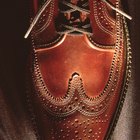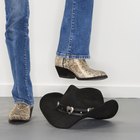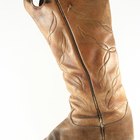
Dyeing leather fabric is a project you can complete successfully in less than a day. The method is the same whether you're dyeing a piece of leather for sewing or crafts, or a finished garment or accessory. All you need is dye that's intended for leather. A surprising difference between dyeing leather and other fabrics is that with enough coats of dye, you can use any shade of leather dye on any color leather.
Supplies
The most essential supply for dyeing leather is leather dye, which is formulated specifically for the job and is available at online leather product websites and some crafts and fabric stores. Leather finisher, which seals the dye, is useful for this project but not essential. Some finishers also add a shine to the dyed leather. Use clean sponges or rags that you already have around the house to apply leather dye, or purchase a special wool dauber, which is a pad of wool attached to a handle that you use in the same way as a paintbrush. A paintbrush is also handy for applying dye to fiddly parts of leather garments and accessories. Find a drop cloth to protect your surfaces. You will also need rubber gloves, old clothing and an apron.
Preparation
Unless your leather is brand new, clean it before you begin dyeing. Surface grease and grime will interfere with the application of the dye. Use baby wipes, leather cleaner or acetone. If you are dyeing a leather item that includes seams or hardware, such as buckles on a bag or zippers on a jacket, cover these parts with tape to protect them from the dye. Take your leather fabric and supplies to a well-ventilated area and lay down a drop cloth to protect your surfaces from the dye. If you work outside on a warm day, the drying time will be quicker than if you work inside.
Application
The application process for leather dye is quite simple. Dampen the surface of the leather with cold water. Use a sponge or rag and aim to dampen -- not saturate -- the surface. Apply the dye with a second clean sponge or rag, or dauber. Rub the dye onto the leather using a circular motion until you've covered the whole surface of the leather. Start with a small amount of dye and adjust the saturation as you see fit. Use a paintbrush to apply dye to hard-to-reach areas. Don't worry if the color isn't to your satisfaction with just one coat. You may need to apply two or more coats of dye to get the color you want. Let each coat of dye dry completely before applying the next.
Finishing
After the final coat of dye is dry, buff the leather with a clean, dry rag to remove any excess dye. Apply a fine coat of leather finisher with a clean, damp sponge or rag, following the manufacturer's instructions. This prevents the dye from transferring onto other materials.
Related Articles

How to Change the Color of Leather

How to Dye White Leather Shoes

How to Dye Leather Sneakers

Coloring a Faded Leather Jacket

How to Clean a Chamois Leather Jacket ...

How to Re-Dye Leather Shoes

How to Waterproof a Leather Jacket

How to Darken Faded Black Leather

How to Dye Leather Shoes From Brown to ...

Denatured Alcohol Uses

How to Care for Snakeskin Boots

How to Dye Cowboy Boots

How to Dye Faux Leather

How to Keep Shoes from Leaving Black ...

How to Alter the Length of a Leather ...

Making Leather Less Stiff

How to Care for Napa Leather

How to Re-Dye Your Leather Coat

How to Dye Suede Boots Dark Grey

How to Care for Moccasins
References
Writer Bio
Joanne Thomas has worked as a writer and editor for print and online publications since 2004. Her writing specialties include relationships, entertainment and food, and she has penned pieces about subjects from social media tools for Adobe to artists’ biographies for StubHub. Thomas has also written for such names as Disney, Hyundai, Michelob and USA Today, among others. She resides in California and holds a bachelor’s degree in politics from the University of Bristol, U.K.
Photo Credits
Thomas Northcut/Photodisc/Getty Images